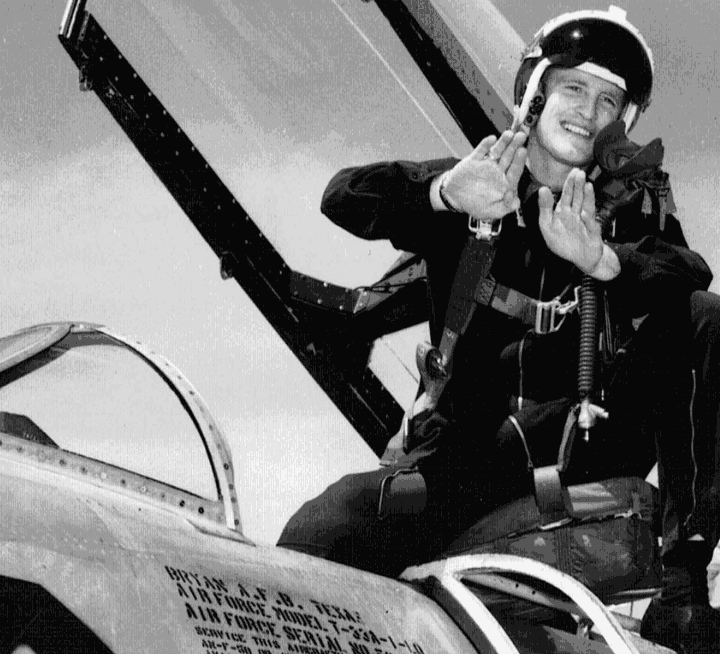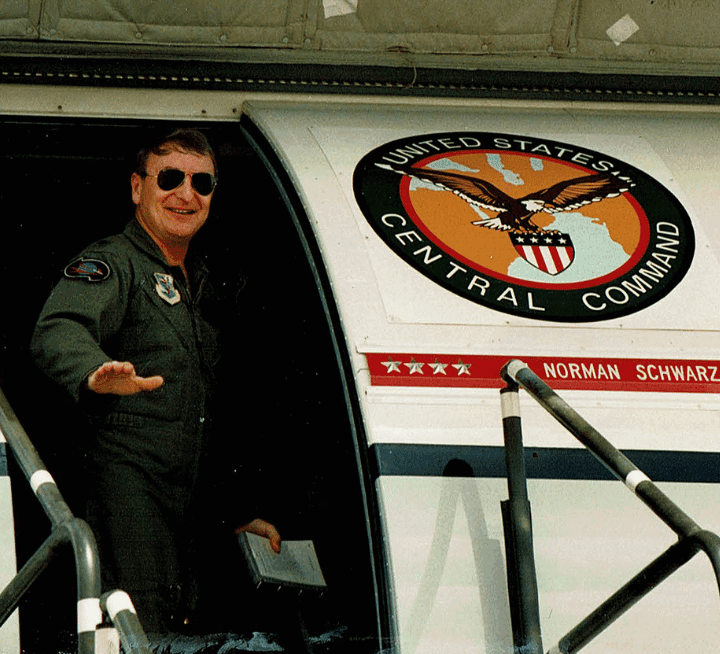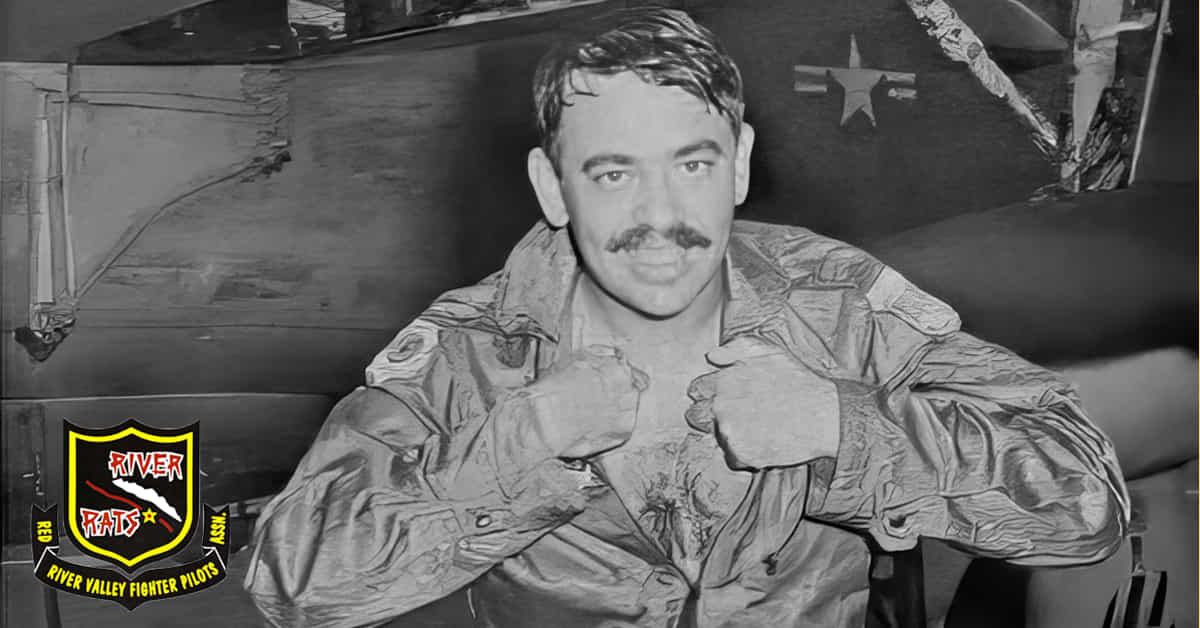
An original “Wild Weasel” and River Rat remembered
Originally published on June 19, 2013 by Airman 1st Class Joshua Kleinholz as a news feature on the Air Force Air Combat Command website. Lt. Col Sparks was a member of the Red River Valley Fighter Pilots Association.
Lt. Col. Billy R. Sparks F-105 History compiled by W. H. Plunkett
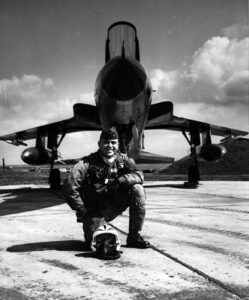 On Dec. 7, 1941, a boy named Billy R. Sparks was celebrating his seventh birthday in the small community of Hardyville, Ky. Born to parents Coy and Kathleen Sparks, Billy became a student of military history at a relatively young age, studying the Civil War and other U.S. conflicts in order to satisfy his thirst for knowledge.
On Dec. 7, 1941, a boy named Billy R. Sparks was celebrating his seventh birthday in the small community of Hardyville, Ky. Born to parents Coy and Kathleen Sparks, Billy became a student of military history at a relatively young age, studying the Civil War and other U.S. conflicts in order to satisfy his thirst for knowledge.
For Billy, Dec. 7 was just his birthday. It held no other significance, no other baggage. It was his day to be celebrated by friends and family. As he blew out the last of his seven candles, he was unaware that Dec. 7 would never be normal again. He didn’t know that approximately 4,500 miles away, 353 Japanese aircraft were converging on Pearl Harbor, Hawaii, determined to make some history of their own.
“That made a big impression on him,” said Allen Reid Sparks of his father, retired Air Force Lt. Col. Billy “Sparky” Sparks. “That was a time when we had a lot of pride in our nation, and I believe that what happened made him determined to serve his country from an early age.”
Sparky’s dedication and passion for knowledge was taking him places. After graduating with a bachelor’s degree in business from Indiana University in 1957, he was commissioned by the Air Force and immediately began pilot training, earning a fighter pilot assignment in 1958.
He completed F-100 Super Sabre Combat Crew Training in 1959 at Nellis AFB, and spent his first four years as a fighter pilot with the 8th Tactical Fighter Squadron at Spangdahlem Air Base, Germany. It was during these years that Sparky was introduced to the aircraft that would define his career – the Republic F-105 Thunderchief.
His follow on assignment was McConnell AFB, Kan., where he spent another four years mastering the Thunderchief, commonly referred to as the “Thud” by pilots and aircrews.
Determined to be the best pilot he could be, then Capt. Sparks returned to Nellis AFB to attend the rigorous Fighter Weapons Instructor Course in his beloved “Thud”, where his relentless passion for excellence in his weapons system made an impression on his peers.
A testament to his knowledge and technical prowess, Sparks graduated as Top Gun of his class at the FWIC in 1966. His natural skill, unparalleled dedication and affinity for risk made him a perfect candidate for the Air Force’s new “Wild Weasel” concept, formed in response to the growing threat of Soviet-built S-75 Dvina surface-to-air missile sites being built throughout North Vietnam. U.S. pilots in Vietnam had never seen SAMs before, and new tactics were necessary to mitigate already heavy losses.
He was up for the challenge.
As part of this new strategy, select F-105s would be outfitted with more advanced radar, jamming equipment and a heavier armament. “Wild Weasels ” would fly into a target area preceding a main strike force to essentially “bait” enemy SAM sights into locking on and firing on them. The Weasel crew, consisting of a pilot and an Electronic Warfare Officer, would then identify the enemy SAM sight, record its location, make defensive maneuvers to avoid being hit by the missile and organize a strike against it, all while engaging any enemy fighters in the area; a risky job for the boldest of men.
Sparks completed F-105 Wild Weasel School in 1967. After mastering the skills required to carry out the Weasel mission, he was immediately deployed to the Takhli Royal Thai Air Force Base near Bangkok, Thailand, with the 357th Tactical Fighter Squadron in support of Operation Rolling Thunder. Aircraft from the 355th Tactical Fighter Wing were using Takhli as a “launching pad” for mounting massive strikes against often heavily-defended North Vietnamese industrial targets. Prior to the arrival of the Wild Weasels, the U.S. saw heavy losses in the area which, by the end of the operation, amounted to 938 aircraft lost.
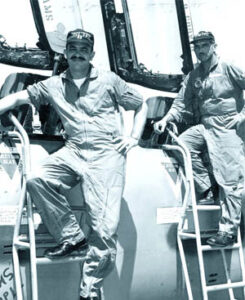 During his eight months in Takhli, Sparks and his EWO, Maj. Carlo Lombardo, flew 82 combat sorties in and out of heavily contested areas surrounding Hanoi.
During his eight months in Takhli, Sparks and his EWO, Maj. Carlo Lombardo, flew 82 combat sorties in and out of heavily contested areas surrounding Hanoi.
“I flew 24 combat sorties in June of 1967, our first month there,” Sparks said in an article recounting his time in theatre. “Of the 24 sorties we flew, we led 18; we were very busy and very tired.” The complexity and danger of the Wild Weasel mission required a high level of chemistry between a Thud pilot and his EWO, and Sparky and Lombardo had built a reputation for being seamless communicators.
“We did argue just a wee bit, but we, neither of us, ever really wanted to kill the other,” Sparks said, poking fun at his “back seater” Lombardo, an expert in radar systems and missile tracking. Before the Wild Weasel concept, EWOs were employed mainly on large bomber aircraft as a means to help the pilot avoid incoming radar signals and SAMs. Now, however, they were to be strapped in behind fighter pilots like Sparky, tasked with seeking out and striking the missile sites they once swore to evade.
“I had been in the business for more than eight years, and I really didn’t know squat about the systems that were designed to kill me,” Sparks said. He studied tirelessly with Lombardo between sorties to gain a better understanding of all the electronic warning systems involved.
“By late summer 1967, we were like a well-oiled machine and could communicate with little grunts and groans,” Sparks said. “I flew with a few other [EWOs] after Carlo went to Saigon, and we flat could not work the way Carlo and I did.”
Sparky’s actions during those 82 combat sorties earned him seven Distinguished Flying Crosses, and an astounding three Silver Stars. On one occasion intentionally becoming the target of a North Vietnamese MiG aircraft so that it could be shot down by the famous triple-ace Brig. Gen. Robin Olds, 8th Tactical Fighter Wing commander.
None of his awards, however, compare to the actions that earned him his third Silver Star.
On Nov. 5, 1967, Sparky and the rest of his flight took off from Takhli RTAFB at 12:30 p.m. and headed towards Hanoi. It was Capt. Sparks’ 146th career combat mission, and his task of the day was to destroy the only remaining hangar at a North Vietnamese air base.
As the strike force converged on the target, three SAMs were launched and flak filled the air. Sparky’s maneuvers evaded the missiles, but his Thud was hit by three 57 mm artillery rounds.
Despite losing all his instruments and flying in an aircraft burning from cockpit to tail, Capt. Sparks stayed with the aircraft and flew it more than 60 miles until it finally went out of control and he was forced to eject over hostile territory. Even with flames bearing down on his cockpit and slightly burning his legs, Sparks had the presence of mind to stay in the powerless aircraft just long enough to cross the Red River into an area that gave him hope of being rescued.
Members of his squadron saw him go down and immediately radioed his position to a pararescue team while circling overhead and engaging enemy threats.
“I’m going to make it; you don’t know how wonderful that feels to think. I am going to make it,” Sparks said, looking back on the day that defined his career. Around two hours later an HH-3 Jolly Green Giant helicopter, flown by U.S. Air Force Capt. Harry Walker, was lowering down a small basket on 135 feet of cable. “Four MiG-17s showed up, and Harry would not leave me,” Sparks said. “His dedication was beyond belief.”
That would be his last combat sortie.
“It was over for him after he got shot down; they made him go home,” said his son. “If he had been allowed, he would have stayed; he wanted to finish his 200 missions.”
Sparks’ contributions to the fighter pilot community were only just beginning. After the war, he immersed himself in the world of testing, tactics and training. He returned to Nellis AFB and became the chief of academics at the very same FWIC he’d once graduated as top gun.
He played an integral role in the complex testing exercises Air Combat Evaluation/Air Intercept Evaluation, organizing test plans, test control and scheduling, among other positions throughout the Air Force.
Even after his retirement in 1977, Sparks continued his dedication to optimizing American air power. He worked with Lockheed and various other defense contractors, lending his experience and knowledge to the development of various test and evaluation programs that would produce technologies and tactics.
Perhaps one of his most valuable contributions to today’s fighter pilot community was the integral role he played in the Advanced Medium Range Air-to-Air Missile Operational Utility Evaluation, which provided pilots with a beyond-visual-range missile with a “fire and forget” capability. U.S. pilots could now identify, acquire and launch a missile at an enemy target while avoiding detection, staying out of range, and increasing efficiency. The project also greatly improved pilots’ situational awareness, which in turn increased their survivability in the air conflicts to come.
Sparks passed away in 2013 leaving his family, friends and colleagues with a lifetime of memories, lessons and “bad jokes.”
After being pulled out of a bamboo forest with a broken elbow and kneecap, a dislocated shoulder and fractured feet, all Sparky wanted to do was spend the rest of his life with family and friends along with his wife Dell, who he called “the most beautiful woman in the world.”
Mission accomplished.


